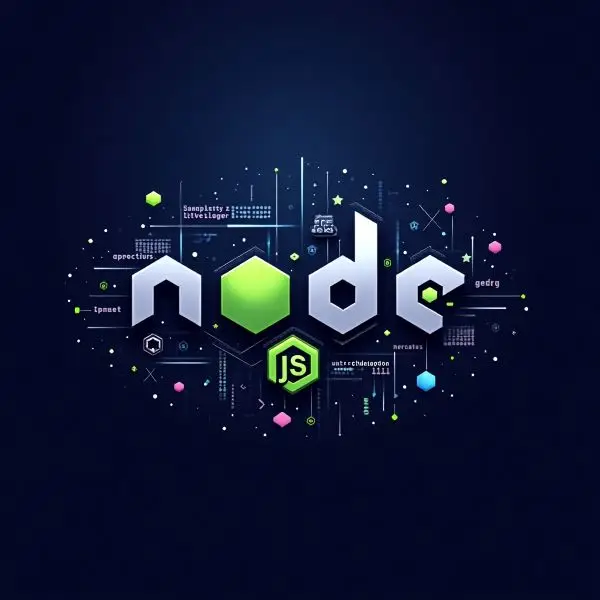
Get Started with GitHub API in Node.js for Beginners
Welcome to this beginner-friendly tutorial where you'll learn how to harness the power of the GitHub API using Node.js. GitHub, the world's leading platform for version control and collaboration, provides a wealth of data and functionalities through its API. Whether you want to automate repetitive tasks, gather meaningful insights from repository data, or build applications that leverage GitHub's features, understanding how to interact with the GitHub API is an essential skill.
In this tutorial, we're going to guide you through the process of accessing and using the GitHub API with Node.js. Our goal is to equip you with the foundational knowledge required to start building your own applications that can interact with GitHub in exciting and innovative ways.
List of Contents
Prerequisites
Before diving in, ensure you've got a few basics covered:
- Basic Understanding of Node.js and JavaScript: You should be familiar with writing and running JavaScript code, especially in a Node.js environment. Don't worry if you're not a Node.js expert — we'll cover the essentials to get you started.
- GitHub Account: Having a GitHub account isn't strictly required, but it's highly recommended. This will allow you to generate personal access tokens for authenticated requests later in the tutorial, as well as explore various GitHub API features that interact with your account.
By the end of this tutorial, you'll be able to make basic authenticated and unauthenticated API requests, understand how to handle responses, and explore some advanced features. So, let's get started and unlock the potential of the GitHub API with Node.js!
What is the GitHub API?
The GitHub API provides programmable access to various features of the GitHub platform, allowing developers to automate tasks, integrate with external systems, and build applications that enrich the GitHub ecosystem.
At its core, the GitHub API is a RESTful API, which means it uses HTTP requests to interact with resources hosted on GitHub. These resources can be anything from user profiles and repositories to commits and issues. By utilizing the GitHub API, developers can programmatically access this data, perform various operations, and even manage workflows without the need for direct interaction with the GitHub.
Use Cases
The flexibility and power of the GitHub API open up a wide range of possibilities. Here are some common use cases where the GitHub API shines:
- Repository Management: Automate tasks related to repository creation, content updates, or access management, which can save time in deployment pipelines.
- Data Analytics and Insights: Retrieve data such as commit history, pull requests, or issue logs to perform analytics and gain insights into project activity and contributor engagement.
- Custom Tools and Applications: Build custom dashboards, integrate with CI/CD systems, or create bots that interact with repositories and post updates on issues or pull requests.
- Automated Testing and CI/CD Integration: Trigger builds or tests based on events such as commits or pull requests, ensuring that the quality of code is maintained without manual oversight.
By the time you finish this tutorial, you'll have a strong foundation to begin exploring these and other exciting possibilities that the GitHub API offers.
Setting Up the Environment
Before we dive into making requests to the GitHub API with Node.js, it's essential to set up your development environment. This ensures you have all the necessary tools and packages in place to smoothly follow along with the tutorial.
1. Node.js and npm Installation
To get started, you need Node.js and npm installed on your machine. Node.js is a JavaScript runtime that allows you to execute JavaScript code outside a web browser, while npm (Node Package Manager) helps manage packages or dependencies in your projects.
- Check Installation: If you're unsure whether Node.js is installed, open your command line (Terminal on macOS or Command Prompt on Windows) and run:
If Node.js is installed, you'll see the version number. Similarly, check npm with:node -vnpm -v - Installation: If Node.js and npm are not installed, download and install them from the official Node.js website. The installation includes npm as well. If you don't know how to install Node.js you can follow our guide.
2. Creating a New Node.js Project
With Node.js and npm set up, the next step is to create a new Node.js project where you'll write the code to interact with the GitHub API.
- Initialize Project:
- Navigate to your desired directory in the command line.
- Run
npm initto initialize your project. You'll be prompted to enter details like the package name, version, description, etc. You can accept the default values or customize them.
This command creates a new directory for your project, navigates into it, and initializes it with default values.mkdir github-api-tutorial cd github-api-tutorial npm init -y - Understand package.json:
- The
package.jsonfile is created in your project directory. It holds metadata about your project and manages dependencies, scripts, and more.
- The
3. Installing Required Packages
To interact with the GitHub API, you'll need an HTTP client library. We'll use Axios, a promise-based HTTP client, which is simple to use and integrates well with modern JavaScript.
- Install Axios:
npm install axios - Why Axios?
Axios is popular for its ease of use, built-in promise support, and ability to handle various HTTP requests and responses. While there are other alternatives like
node-fetch, Axios's robust feature set and simplicity make it a great choice for beginners.
Once you complete these steps, your development environment will be ready to start making requests to the GitHub API. In the upcoming sections, we'll cover making your first API requests and handling responses effectively.
Understanding GitHub API Authentication
To access certain endpoints of the GitHub API, especially those involving private data or extended access, authentication is crucial. This section will introduce you to GitHub API authentication using Personal Access Tokens.
Personal Access Tokens
The GitHub API offers various ways to authenticate your requests, with Personal Access Tokens (PATs) being one of the most straightforward methods for developers. These tokens allow you to authenticate with the API without using your password, providing a layer of security and flexibility.
Why Use Personal Access Tokens?- Access Control: Tokens can be granted different scopes, allowing you to finely control the access and operations permitted for that token.
- Security: Unlike passwords, tokens can be easily revoked without affecting your account's overall security, and they don't expose your account password if leaked.
- Convenience: You can generate tokens for specific tasks or projects, managing them separately.
Follow these steps to create a Personal Access Token:
- Log in to GitHub: Navigate to your GitHub account settings.
- Go to Developer Settings: In your settings, find and click on "Developer settings."
- Access Personal Access Tokens: Click on "Personal access tokens" in the leftside menu.
- Click "Generate new token".
- Give your token a descriptive name.
- Assign scopes based on your project needs (e.g.,
repofor repository access oruserfor profile access). - Click "Generate token" and securely save the generated token. Remember, you will not be able to view it again.
It's crucial to protect your Personal Access Token to prevent unauthorized access to your GitHub account. Here are some best practices:
- Never Hardcode Tokens: Avoid directly embedding your tokens in your source code. Instead, use environment variables or configuration files that are not included in version control.
- Revocation: Immediately revoke tokens that you suspect are compromised. You can do this from your GitHub account settings under Personal Access Tokens.
- Limit Scopes: Assign only the necessary scopes needed for your application, reducing potential risks if the token is exposed.
With your Personal Access Token ready, you're equipped to make authenticated requests to the GitHub API, enhancing the capabilities of your Node.js application. In the next section, we'll explore making your first API request, both with and without authentication.
Making Your First GitHub API Request
Now that your environment is set up and you have a Personal Access Token ready, it's time to dive into making your first GitHub API requests using Node.js. We'll explore both unauthenticated and authenticated requests, giving you a comprehensive start to interacting with the GitHub API.
1. Basic API Request
Let's start with a simple GET request to fetch public information. We'll use Axios for this task.
Fetching Public User Dataconst axios = require('axios');
// Replace '{username}' with any GitHub username you want to query
axios.get('https://api.github.com/users/{username}')
.then(response => {
console.log(response.data); // Prints the public data of the specified user
})
.catch(error => {
console.error('Error fetching user data:', error);
});Replace {username} with a real GitHub username to see their public profile information, such as name, bio, public repository count, etc.
2. Handling Responses
Understanding the response structure is essential to make effective use of the data returned by the API.
The response object generally contains:
data: The requested information, usually in JSON format.status: The HTTP status code (e.g., 200 for success).headers: Metadata associated with the response.
It's important to handle errors gracefully, either by notifying users or retrying requests, depending on the scenario.
3. Accessing GitHub API with Authentication
Many GitHub API endpoints require authentication, which can be achieved using your Personal Access Token.
Authenticated RequestHere’s how to modify the previous request to include authentication:
const axios = require('axios');
const token = 'YOUR_PERSONAL_ACCESS_TOKEN'; // Replace this with your actual token
axios.get('https://api.github.com/user', {
headers: {
'Authorization': `token ${token}`
}
})
.then(response => {
console.log('Authenticated User Data:', response.data); // Prints authenticated user data
})
.catch(error => {
console.error('Error with authenticated request:', error);
});This example requests data from the authenticated user's GitHub profile.
With these first API calls, you’ve established a baseline understanding of interacting with the GitHub API using Axios in Node.js, both unauthenticated and authenticated. Up next, we'll dive into more advanced API features and learn how to handle responses effectively.
Exploring Advanced API Features
Now that you have made your first API requests, it's time to explore some of the advanced features the GitHub API offers. This will allow you to perform more complex operations and handle larger datasets effectively.
Requesting Different Resources
The GitHub API exposes a wide array of endpoints to interact with various resources. Here are some examples of what you might want to access:
Fetching RepositoriesYou can retrieve details about repositories that belong to a user or organization. Let's fetch the repositories for your authenticated user:
const axios = require('axios');
const token = 'YOUR_PERSONAL_ACCESS_TOKEN'; // Replace with your token
axios.get('https://api.github.com/user/repos', {
headers: {
'Authorization': `token ${token}`
}
})
.then(response => {
console.log('Repositories:', response.data); // Displays a list of repositories
})
.catch(error => {
console.error('Error fetching repositories:', error);
});In addition to fetching user repositories, the GitHub API allows you to interact with issues and pull requests, which are essential components of project management and collaboration in repositories.
Fetching IssuesHere's how you can fetch issues from a specific repository using the GitHub API:
const axios = require('axios');
const token = 'YOUR_PERSONAL_ACCESS_TOKEN'; // Replace with your token
const owner = 'owner'; // Replace with the repository owner's username
const repo = 'repository'; // Replace with the repository name
axios.get(`https://api.github.com/repos/${owner}/${repo}/issues`, {
headers: {
'Authorization': `token ${token}`
}
})
.then(response => {
console.log('Issues:', response.data); // Displays a list of issues in the repository
})
.catch(error => {
console.error('Error fetching issues:', error);
});Replace owner and repo with the appropriate repository owner and name to fetch the list of issues.
Similarly, you can retrieve pull requests from a repository:
const axios = require('axios');
const token = 'YOUR_PERSONAL_ACCESS_TOKEN'; // Replace with your token
const owner = 'owner'; // Replace with the repository owner's username
const repo = 'repository'; // Replace with the repository name
axios.get(`https://api.github.com/repos/${owner}/${repo}/pulls`, {
headers: {
'Authorization': `token ${token}`
}
})
.then(response => {
console.log('Pull Requests:', response.data); // Displays a list of pull requests
})
.catch(error => {
console.error('Error fetching pull requests:', error);
});By accessing issues and pull requests, you can automate tasks like generating reports, integrating notifications in chat applications, or building dashboards that provide insights into project activities.
Pagination Handling
When working with APIs, especially for operations like fetching repositories or commits, you might encounter situations where you receive large sets of data. The GitHub API employs pagination to manage this.
Understanding PaginationMost API responses will be paginated and include metadata in response headers that indicate the position within the dataset. Here's how to handle paginated requests:
const axios = require('axios');
const token = 'YOUR_PERSONAL_ACCESS_TOKEN'; // Replace with your token
axios.get('https://api.github.com/user/repos', {
headers: {
'Authorization': `token ${token}`
},
params: {
per_page: 100, // Number of results per page
page: 1 // Current page number
}
})
.then(response => {
console.log('Page 1 Repositories:', response.data);
// Check 'Link' header for pagination
console.log('Link header:', response.headers.link);
})
.catch(error => {
console.error('Error handling pagination:', error);
});- Check the
Linkheader in the API response forrel="next"to determine if there are additional pages of results. - Use the
per_pageparameter to specify the number of results to return per page, which can be adjusted according to your needs and rate limits.
These advanced features allow you to efficiently interact with GitHub resources and manage large datasets with ease. Armed with these capabilities, you're well on your way to building sophisticated applications that leverage the full power of the GitHub API.
Summary
Congratulations on completing this tutorial on getting started with the GitHub API using Node.js! You've taken a significant step towards mastering how to programmatically interact with one of the most popular platforms for version control and collaboration in the software development world.
The skills you've gained in this tutorial will enable you to build applications that automate workflows, analyze data, and integrate GitHub functionalities seamlessly into other platforms. As algorithms and GitHub's API evolve, keeping your skills sharp will empower you to tackle increasingly complex challenges with confidence.
Thank you for embarking on this tutorial, and happy coding!



